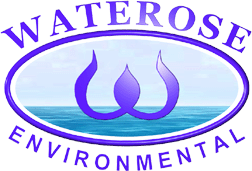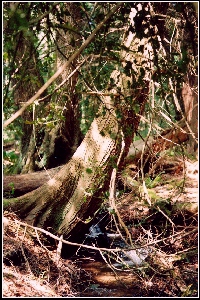 | ||||||
| Articles | Projects | Resume | Cartoons | Windsurfing | Paintings | Album |
Esquimalt Lagoon
State of the Ecosystem Report

Water Quality Analysis Project 1998
Waterose et. al.

Section 8. Analysis Procedure:
Quality Assurance and Quality Control Program
Analysis
Field Analysis
Laboratory Analysis
Nitrates Analysis
Fecal Coliform Analysis
Hydrocarbon Analysis
Statistical Analysis
Quality Assurance and Quality Control Program:
Critical decisions in regard to the management of land, issues, and resources can be based on data collected and derived from laboratory analysis. As a result, there is a need to have a quality assurance (QA), and a quality control (QC) program. QA is a necessary part of data collection. It serves as a guide for obtaining quality data in laboratory operations. QC is a set of measures within a sample analysis methodology that assures the process is sound (Csuros, 1994).QA was developed for this study to obtain high quality defensible data and report results with a high level of confidence. QC measures were taken to assure that the process was in control. The QA/QC program was continually reviewed and updated during the course of the project (Csuros, 1994).
The QA/QC program was incorporated into the sampling procedures in the field, documentation control, calibration procedures in both the field and the lab, duplicate controls, and outside professional lab analysis.
A plan for quality assurance with specific standard procedures was established (Csuros, 1994). As part of the QA/QC program, the equipment was autoclaved. Duplicate samples were obtained to verify the accuracy of the results. The equipment was calibrated, either in the field and the laboratory, immediately prior to the measurements. Some stock solutions were prepared in house on a weekly basis in the laboratory while other solutions were purchased.
The final results of a parameter was obtained by taking the mean value of all data sets for each site. In addition, approved analytical methods and references were used while a few samples were sent to a reputable analytical laboratory.
Analysis:
Good environmental studies require both laboratory and field analysis to measure parameters. Then, statistical analysis is required to determine the validity of the measurements and to make comparisons and extrapolations. The statistical validity must be determined because it is impossible to obtain the actual value of a parameter being investigated. This is due to the dynamic nature of environmental parameters. Thus, by convention, the ninety-five per cent confidence level was used for statistical analysis.
Field Analysis:
Some parameters must be tested in the field. These are general water quality parameters that are commonly collected with most aquatic sampling. They include: pH, temperature, and conductivity. In addition to field analysis, precipitation data for the twenty-four hour period immediately prior to sampling were obtained from Mr. MacDuff at the Victoria meteorological center. The data are important for statistical analysis and correlation to help interpret results.
Laboratory Analysis:
The laboratory analysis of nitrate and fecal coliform levels was completed in-house at RRU using procedures and protocols outlined in the RRU Environmental Science Lab Manual (1998). For the hydrocarbon analysis, EPA methods 3500/8015 was used by Analytical Services Laboratories Ltd. (ASL) in Vancouver BC.
Nitrates Analysis:
The concentration of nitrate ions was analyzed using a spectrophotometric method. It was completed using standard solutions and by reducing nitrate to nitrite with zinc. The nitrite reacts with sulphanic acid and napthylamine hydrochloride to produce a red azo dye (Ondrus, 1993).
Fecal Coliform Analysis:
The membrane filtration technique was used to determine the fecal coliform count for each water sample. This technique involved water filtration and incubation of fecal coliform sub-cultures on selective agar plates (Royal Roads, 1997).
Hydrocarbon Analysis:
Substances that resembled petroleum oils were observed leaching into the Lagoon and into one of the ponds. Although this was outside the specific focus of this project, some sediments from these sites were analyzed to determine if they contained petroleum hydrocarbons.Laboratory analysis was completed on four sediment samples, which included a duplicate, by Analytical Services Laboratories Ltd. (ASL) in Vancouver BC. ASL carried out the analysis for light (C10-C18) and heavy (C19-C32) extractable hydrocarbons, LEPH and HEPH respectively.
The hydrocarbon analysis used a procedure adapted by ASL from US EPA methods 3500/8015, as well as the British Columbia Ministry of Environment, Lands and Parks’ Method for “Extractable Petroleum Hydrocarbons in Soil by GC/FID” (1996). The procedure involved a hexane/acetone solvent extraction. The extract was then analyzed by a capillary column gas chromatography with a flame ionization detection. The extractable petroleum hydrocarbon (LEPH/HEPH) results were not adjusted for polycyclic aromatic hydrocarbons (PAHs).
Statistical Analysis:
The statistical analysis was computed with the computer software, Systat 7.01. The types of analysis included basic descriptive statistics, t-tests, and Analysis of Variance (ANOVA).
To Section 9. Results
Index:
- Introduction
- History and Land Use
- Geomorphology
- Nutrients and Coliforms
- Red Tides and Fish Kill
- Hydrocarbons
- Sample Procedure
- Analysis Procedure
- Results
- Discussion
- Future Study
- References
- Photo Album


 email Waterose
email Waterose
Please Sign My Guestbook
Please View My Guestbook

| Articles | Projects | Resume | Cartoons | Windsurfing | Paintings | Album |
 | ||||||